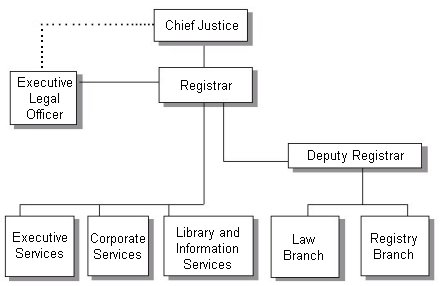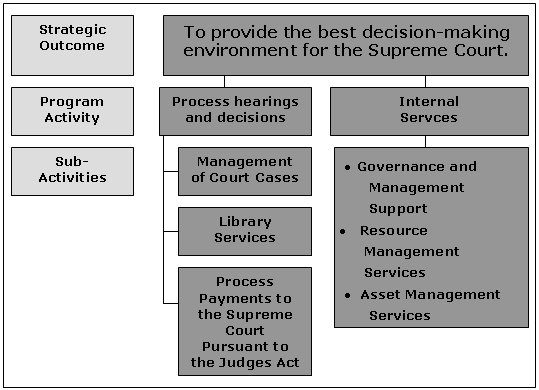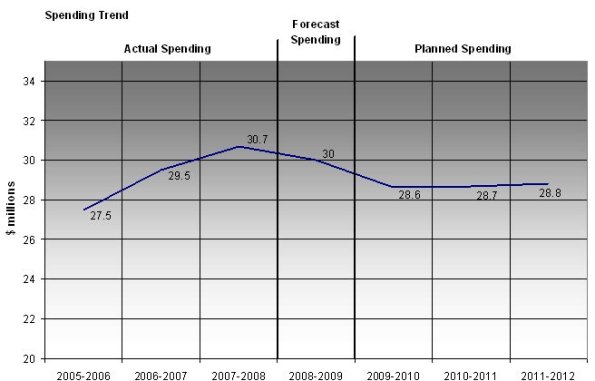Common menu bar links
Breadcrumb Trail
ARCHIVED - Supreme Court of Canada
 This page has been archived.
This page has been archived.
Archived Content
Information identified as archived on the Web is for reference, research or recordkeeping purposes. It has not been altered or updated after the date of archiving. Web pages that are archived on the Web are not subject to the Government of Canada Web Standards. As per the Communications Policy of the Government of Canada, you can request alternate formats on the "Contact Us" page.
I: Departmental Overview
A. Registrar's message

I am pleased to present the 2009-2010 Report on Plans and Priorities for the Supreme Court of Canada.
The Supreme Court of Canada is Canada's final court of appeal. It serves Canadians by leading the development of common and civil law through its decisions on questions of public importance. The independence of the Court, the quality of its work and the respect in which it is held contribute significantly as foundations for a secure, strong and democratic country.
The Office of the Registrar of the Supreme Court of Canada understands keenly the importance of the role of the Court and focuses its efforts on a single strategic outcome: to provide the best decision-making environment for the Court.
Though the core work of the Office continues to be the processing of cases and our projected caseload for the coming year remains relatively stable, the decision-making environment continually evolves, dictating new risks, challenges and opportunities. In the past few years, these have been mainly technological ones, as the Court undertook a major modernization initiative. Now that courtroom systems are stable and the implementation of an electronic document and records management system is well underway, focus will shift to adapting business processes to the new environment. I am confident that, though change is always difficult, the managers and employees of the Court will dedicate themselves as always to serving the judges and Canadians with professionalism and now with a renewed sense of purpose.
In addition to ensuring that our people and our processes are up to the challenge, we will be focusing on two management priorities in 2009-2010: developing and implementing an information management strategy and program; and finalizing and implementing our business continuity program.
Unusually, I am presenting this report instead of our new Registrar, Roger Bilodeau, who was appointed on January 23, 2009 to replace Anne Roland, who retired in 2008, following 18 years of service in that position. The judges and staff look forward to working with a new deputy head and with the recently appointed Justice Thomas A. Cromwell - two new important changes that I am positive the staff of the Office of the Registrar will handle with alacrity!
Name: _____________________
Louise Meagher
Title: Deputy Registrar
Date: January 26, 2009
B. Raison d'être
As the final court of appeal, the Supreme Court of Canada serves Canadians by leading the development of common and civil law through its decisions on questions of public importance. The mandate of the Supreme Court of Canada is to have and exercise an appellate, civil and criminal jurisdiction within and throughout Canada, which it meets by hearing and deciding cases of public importance. In accordance with the Supreme Court Act, the Supreme Court of Canada consists of the Chief Justice and the eight Puisne Judges.
The Office of the Registrar of the Supreme Court of Canada exists to provide the full gamut of services the Court needs in order to hear cases and render decisions, and serves as the interface between the litigants and the Court. The focus of this report is the Office of the Registrar of the Supreme Court of Canada.
More detailed information on the Court’s responsibilities, the hearing process and judgments is available on the Internet (http://www.scc-csc.gc.ca/home-accueil/index-eng.asp).
C. Responsibilities
The Supreme Court of Canada comprises the Chief Justice and the eight Puisne Judges, all of whom are appointed by the Governor in Council. The Supreme Court of Canada is the highest Court in Canada and one of its most important national institutions. It hears appeals from the decisions of the courts of appeal of the provinces and territories as well as from the Federal Court of Appeal. In addition, the Court is required to give its opinion on any question referred to it by the Governor in Council. The importance of the decisions of the Court for Canadian society is well recognized. The Court assures uniformity, consistency and correctness in the articulation, development and interpretation of legal principles throughout the Canadian judicial system. Its jurisdiction is derived from the Supreme Court Act and other Acts of Parliament, such as the Criminal Code.
The Registrar, also a Governor in Council appointee, reports to the Chief Justice, and heads the Office of the Registrar of the Supreme Court of Canada. The organization of the Office of the Registrar is depicted in the following diagram and further explained in the paragraphs that follow.

Executive Services
Appointed by the Governor in Council, the Registrar is the Deputy Head of the Court, is subject to the direction of the Chief Justice and exercises quasi-judicial powers. The Registrar’s Office provides executive services to the chambers of the nine Judges, the office of the Executive Legal Officer, the law clerk program, and dignitary visits.
Court Operations Sector
The Deputy Registrar, a Governor in Council appointee, oversees the work of the Court Operations Sector, which includes the Registry Branch and the Law Branch. Public information services, including the management of the Court's Tour Program, are also provided by staff in the Deputy Registrar's Office.
Library and Information Services Sector
Library and Information Services are provided by the Library and Information Management/ Technology branches. Sector services are designed primarily to serve the Court and its business units, and through them litigants, the media and the public. These responsibilities extend to the corporate level where this centre of expertise is charged with ensuring that the management of the Court's information meets legislative and central agency requirements.
Corporate Services Sector
The administrative support to the Judges and Court staff is provided by the Corporate Services Sector, which is responsible for accommodation, telecommunications, health and safety, finance, procurement, human resources, administration, security, strategic planning, reporting and project management.
D. Strategic Outcome and Program Activity Architecture (PAA)
The Office of the Registrar of the Supreme Court of Canada has a single strategic outcome: To provide the best decision-making environment for the Supreme Court. The following illustrates the Supreme Court of Canada’s framework of program activities and sub-activities which contribute to progress toward the Court’s Strategic Outcome.

E. Planning Summary
| 2009-10 | 2010-11 | 2011-12 |
|---|---|---|
| 28.6 | 28.7 | 28.8 |
The financial resources table above provides a summary of the total planned
spending for the Office of the Registrar for the next three fiscal years.
| 2009-10 | 2010-11 | 2011-12 |
|---|---|---|
| 201 | 201 | 201 |
The human resources table above provides a summary of the total planned human resources for the Office of the Registrar for the next three years.
Summary table
| Performance Indicators | Targets |
|---|---|
| Level of satisfaction among judges regarding quality of service | Annual interviews with Judges Target: “Satisfied” level |
| Level of satisfaction among lawyers regarding quality of service | Annual interviews with Judges Target: “Satisfied” level |
| Program Activity1 | Expected Results | Forecast
Spending 2008-09 |
Planned Spending | Alignment to Government of Canada Outcomes | ||
|---|---|---|---|---|---|---|
| 2009-10 | 2010-11 | 2011-12 | ||||
| Process hearings and decisions |
|
30.0 | 28.6 | 28.7 | 28.8 |
Government Affairs The Supreme Court of Canada stands at the apex of the Canadian judicial system, and as such is a fundamental element of the Canadian structure of government. |
| Total Planned Spending | 30.0 | 28.6 | 28.7 | 28.8 | ||
| Less: Non-respendable revenue | (0.2) | (0.2) | (0.2) | (0.2) | ||
| Plus: Cost of services received without charge | 9.4 | 9.4 | 9.2 | 9.2 | ||
| Total Departmental Spending | 39.2 | 37.8 | 37.7 | 37.8 | ||
F. Contribution of Priorities to Strategic Outcome
The focus of the Office of the Registrar will continue to be the processing of cases without delay while maintaining stakeholder satisfaction and high standards of service quality, and keeping backlogs to a minimum. In addition, the Office of the Registrar has two management priorities for 2009-10 which are driven by the government-wide agenda to improve the management of the public service and its programs.
| Management Priorities | Type | Links to Strategic Outcome(s) | Description |
|---|---|---|---|
| Develop and implement an information management strategy and program | New | To provide the best decision-making environment for the Supreme Court |
Why is this a priority? Given the increasing complexities of cases before the Court and the amount and numerous sources of information available, the Office of the Registrar must provide an improved information management base to better support the business of the Court Plans for meeting the priority
|
| Finalize and implement the business continuity program | New | To provide the best decision- making environment for the Supreme Court |
Why is this a priority? It is essential to secure the effectiveness of the Court by safeguarding employees, information, and assets and ensuring the continued availability of the Court’s essential services Plans for meeting the priority
|
G. Risk Analysis
The environment within which the Office of the Registrar must carry out its activities is continually evolving. The legal environment is becoming increasingly complicated and technological advancements place ongoing pressure on the Court to update its facilities, systems and services. In order to mitigate risk, the Office of the Registrar's focus for the last three years has been on modernizing the courtroom and on enhancing electronic access to the Court for litigants and Canadian citizens. Major technological changes have been instituted and the Office of the Registrar must now solidify and leverage these new technologies by ensuring that work processes are adapted to the new environment.
As well, an ongoing challenge faced by the Office of the Registrar is one that is shared by many small agencies - that is, the struggle to maintain operations and address specific challenges, while complying with the same expectations and requirements (e.g. reporting) from central agencies as are demanded of large, more flexibly resourced departments.
The following provides more information about major factors affecting the Office of the Registrar’s operations.
i) Changes and trends in the Court and court administration include:
- New Judge. The appointment of a new Judge to the Supreme Court creates a new dynamic for the Office of the Registrar in supporting the Judges.
- Continued focus on electronic exchange of information. The general public has become more technically savvy, and more comfortable using electronic tools to carry out a wide variety of functions. Consistent with this broad trend, the public expects to be able to use electronic tools to interact with the Office of the Registrar’s systems to obtain information and legal material. Judges and counsel are preparing their cases using electronic documents and require access to these documents electronically during hearings. Counsel are demanding the ability to use electronic information and technology while presenting their cases. Meanwhile, the number of electronic cases from the lower courts is increasing. While the Office of the Registrar has moved towards more electronic acceptance and processing of cases, the requirement for paper-based processes continues, and will continue for some time. As a result, parallel streams of case and information processing is still required. The courtroom modernization project created additional pressure to bridge paper with electronic while maintaining both formats. The focus is now shifting to business transformation and change management.
- Complexity of the legal environment. Factors such as globalization and the growing influence of privacy, security, secrecy and human rights issues continue to increase the complexity of cases heard. Increasingly complicated motions are being filed, and more applications for leave to appeal are being received from self-represented litigants, requiring additional effort and skill to address.
- Recent fluctuations in the caseload of the Court. The workload of the Office of the Registrar in terms of caseload has been very stable over the last 10 years (around 80 appeals heard and judgments rendered per year; 14 appeals as of right and 570 leave applications filed per year). However, in 2006 just over 500 leave applications and 7 appeals as of right were filed which led to a reduction in the appeals heard in 2007 to 52 and number of judgments to 58. It now seems clear that this reduction was an anomaly, as 600 leave applications were filed in 2007 and 548 filed in 2008. The numbers of appeals as of right filed increased to 16 in 2007 and 18 in 2008. Accordingly, the numbers of appeal heard have increased to normal levels - 82 appeals were heard in 2008, and expectations are that a similar number will be heard in 2009. Seventy-four judgments were rendered in 2008.
ii) Government-wide initiatives
- Information Management governance. In a climate of
enhanced accountability and reporting requirements, one of the particular
challenges the Office of the Registrar is faced with in light of the Policy
on Information Management and the Policy on the Management of Information
Technology is finding a balance between enabling the Registrar to meet
his/her obligations as Deputy Head under Treasury Board Policies and
avoiding any compromise to the independence of the Judiciary. The efforts to
streamline the policy framework for the management of information and
technology resources should ensure that the proper tools and mechanisms are
in place to respond to this challenge.
As a result of an Information Management audit conducted in 2005, the Office of the Registrar developed and implemented many of the required elements for the effective governance of its information management. The next step is to ensure all the elements are incorporated into a comprehensive and detailed information management strategy and plan. - Business continuity program. The Court has partially developed measures to provide for the continuity of essential business operations and services. However, the Court’s business continuity program lacks a number of elements such the establishment and implementation of business continuity plans maintenance cycle and procedures for their revision, testing and auditing. There is a risk of disruption of the Court’s activities if the Office fails or is unable to respond and recover from disaster due to a shortage of readily available resources and/or the unavailability of premises required to continue court operations over an extended period of time. Disruption of Registry operations could result in counsel and litigants missing filing deadlines and delay of hearings. The Office of the Registrar needs to finalize its business continuity program as per Government Security Policy and its Operational Security Standard – Business Continuity Planning (BCP) Program. The finalization of the business continuity plan requires the establishment of alternate sites and pandemic plan as well as the preparation and delivery of an educational curriculum.
- Integrated business planning. The Office of the Registrar continues to improve its business planning process by integrating various resource requirements such as human resources, financial resources, assets, information technology and communications as well as risk considerations. The Office of the Registrar uses the human resources plan to forecast its staffing needs, deal strategically with staffing, retention and succession issues, and mobilize and sustain the energies and talents of its managers and employees, enabling them to contribute to the achievement of organizational goals. The Office of the Registrar is also improving the management of learning by focussing learning activities to operational requirements, specific job requirements, organizational future needs and employee development through the use of learning plans. Learning plans are evergreen and reviewed each year during the performance evaluation cycle. This enables the Office of the Registrar to effectively manage its human resources and strategically aligns the organization's efforts to the Clerk's priorities.
H. Expenditure Profile
For 2009-10 fiscal year, the Office of the Registrar plans to spend $28.6 million to meet the expected results of its program activity and contribute to its strategic outcome. As illustrated in the figure below, there was a slight increase in approved funding for the courtroom project from 2006-2007 to 2008-2009.

